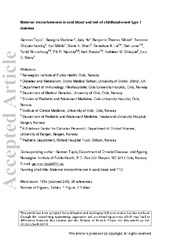Maternal microchimerism in cord blood and risk of childhood-onset type 1 diabetes
Tapia, German; Mortimer, Georgina; Ye, Jody; Gillard, Benjamin Thomas; Chipper-Keating, Saranna; Mårild, Karl Staffan; Viken, Marte K; Lie, Benedicte Alexandra; Joner, Geir; Skrivarhaug, Torild; Njølstad, Pål Rasmus; Størdal, Ketil; Gillespie, Kathleen; Stene, Lars Christian Mørch
Peer reviewed, Journal article
Accepted version
Permanent lenke
https://hdl.handle.net/1956/20701Utgivelsesdato
2019-09Metadata
Vis full innførselSamlinger
Sammendrag
Background: Maternal microchimerism (MMc), the transmission of small quantities of maternal cells to the fetus, is relatively common and persistent. MMc has been detected with increased frequency in the circulation and pancreas of type 1 diabetes (T1D) patients. We investigated for the first time whether MMc levels at birth predict future T1D risk. We also tested whether cord blood MMc predicted MMc in samples taken at T1D diagnosis. Methods: Participants in the Norwegian Mother and Child Cohort study were human leukocyte antigen (HLA) class II typed to determine non‐inherited, non‐shared maternal alleles (NIMA). Droplet digital (dd) polymerase chain reaction (PCR) assays specific for common HLA class II NIMA (HLADQB1*03:01, *04:02, and *06:02/03) were developed and validated. MMc was estimated as maternal DNA quantity in the fetal circulation, by NIMA specific ddPCR, measured in cord blood DNA from 71 children who later developed T1D and 126 controls within the cohort. Results: We found detectable quantities of MMc in 34/71 future T1D cases (48%) and 53/126 controls (42%) (adjusted odds ratio [aOR] 1.27, 95% confidence interval (CI) 0.68‐2.36), and no significant difference in ranks of MMc quantities between cases and controls (Mann‐Whitney P = .46). There was a possible association in the NIMA HLA‐DQB1*03:01subgroup with later T1D (aOR 3.89, 95%CI 1.05‐14.4). MMc in cord blood was not significantly associated with MMc at T1D diagnosis. Conclusions: Our findings did not support the hypothesis that the degree of MMc in cord blood predict T1D risk. The potential subgroup association with T1D risk should be replicated in a larger cohort.
